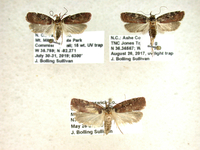Identification
Adult Markings: The following is primarily based on the description in Clarke (1941) and Hodges (1974). The labial palp is cinereus and strongly suffused with reddish. The second and third segments are speckled with blackish scales exteriorly. The third segment has a blackish-fuscous annulus near the base and middle (the former poorly defined) and a blackish-fuscous apex. The antenna is fuscous and annulated with dull cinereus. The head is tawny-red and the face pale cinereus. The thorax is ashy gray except for the darker posterior tip, and often has reddish speckling. The thorax and base of the forewing produce a light diffuse band behind the head that terminates before the costa. The forewing is deep crimson-red to reddish brown and is typically sparsely speckled with black and ashy scales. Some individuals may have a heavy dusting of ashy scales on the apical half that are concentrated towards the costal region. The costa has a tawny-red edge on the basal half that is lighter than the remainder of the forewing. This phases into a series of poorly defined alternating fuscous and darker spots on the apical half. Three discal spots are usually evident. The anterior two (discal spots 'a' and 'b' of Forbes, 1923) that occur at about one-third are relatively small and oblique. These are typically black, but often have ashy or carmine colored scales adjoining them. A prominent white discal spot is present at the end of the cell (discal spot 'd' of Forbes. 1923). The cilia are reddish fuscous and edged with carmine. The hindwing is light fuscous and darker apically than basally, while the cilia are light fuscous with whitish irrorations and pale pink suffusions. The legs are pale cinereous and overlaid and speckled with fuscous and reddish scales, except at the joints. This is a distinctive species that is best distinguished by the deep crimson-red forewing, the lighter tawny-red costal edge on the basal half, the ashy basal band that does not reach the costa, and the prominent white discal spot at the end of the cell. This species is somewhat similar to A. lythrella in terms of wing coloration, but lacks the dark, curved streak on the cell (see comparisons above).
Wingspan: 20-22 mm (Clarke, 1941).Forewing Length: 8.3-9.7 mm (Hodges, 1974)
Adult Structural Features: Clarke (1941) provides detailed descriptions and illustrations of the male and female genitalia.
Adult ID Requirements: Identifiable from good quality photos of unworn specimens.
Immatures and Development: Very little detailed information is available on the larval ecology and life history. The larvae feed on members of the Myricaceae and late instars are light green with fine black dots. Hodges (1974) reported that reared adults emerged during July and August.
Larvae ID Requirements: Identifiable from good quality photos, especially where associated with known host plants.

 »
»


 »
»
